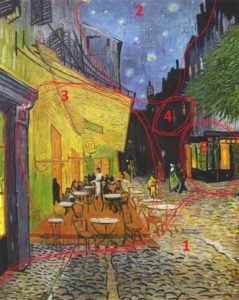
A Brief Guide to Writing in a PbP Setting
You’ve got your ideas, your character is approved, their backstory is interesting, and you know it. But, when you sit to write down the first sentence, you find yourself stumped. You know what they will do, where they will go, what they will say. And all this is reduced to 3 measly lines.
As soon as you post it, a mod pings you: “You are not complying with the writing tenet.” It’s true, you weren’t, but writing sometimes does not come as easy. It’s a skill, of course, one that requires practice and polishing. If you wanna write an epic, you will start with some sentences, after all. But, for those who struggle, a short guide on how to write a teensy bit more.
Step One – Setting
Places, they exist, surround us, and unlike most videogames, in Play by Post roleplaying, they are tangible. There are very few invisible walls keeping your character from things; as long as you have some idea of the place (and for this, the pinned messages or google are your best bet), you can write.
In Seattle by Night we write in the third person perspective, for reasons that we went over on our Guide to Avoid Bleed (check it out, it’s important as well). If you look around you right now, it will become obvious; you are sitting/standing/lying down somewhere, perfect. There are feelings to your body: the way the clothing sits uncomfortably over your shoulders; or perhaps it’s too cold and you need more layers.
The light hits the window in just the right way that you can see specks of dust making a tiny dance. A breeze just blew the curtains around, and there was a flash of brightness that made the room look a bit mystical.
Setting refers to your ability to describe your surroundings (or in this case, your character’s surroundings) in compelling ways. What they see, what they hear, what they feel. Sensory input of all sorts can be used to make a scene more compelling. It’s also essential in building an image of your character. How they interact, what they perceive and when they perceive it, how they perceive it — all of that communicates to the reader many things about who the character is. Choose the details you include with care; make certain they are things which tell the reader something they need to know about either the current situation, the character themselves, or both. Don’t overload on minutiae just to pad the post!
Atmosphere, while tied into setting, is also separate. Think of the things that follow: a fireplace, a damp cavern, and a white empty room. These are all things that can affect and be written upon for your character. A fireplace may make them nervous, due to their inclination to frenzy, or they may find the warmth a type of comfort. A damp cavern may be cold, sending a chill down their spine and causing them to be nervous and uncertain as to what is down here. An empty room? I’ll let you decide.
Don’t forget about mood as well, it’s helpful to follow the mood of a setting. If everyone is angry at the moment, then your character would likely be as well. But if they are not mad… Well, you can explain as to why they are not in your writing. Maybe the execution or branding was something they wanted, or something they might have even enjoyed watching. Remember that we are not our characters and the things they feel and express do not correlate to the people we actually are.
Associated with the second step, well, it helps create the whole.
Step Two – Physicality
People are not statues. True, vampires lose many of the natural tics we as humans have. No eye blinking, no automatic breathing, perhaps not even any fidgeting. But socially, there are cues and body language that can still be used by us, as writers, to help portray their personality, how they are feeling, etc.
Let’s imagine together a character (you can picture yours, if it’s easier). You already have the setting in mind, and as we said above, how they approach things can inform a lot. An aloof character might ignore their friend waving at them from across the room and start looking around. A socially awkward character will try to feel small in a corner, if the setting is full of strangers.
When next to others, they will position themselves accordingly. A seductive character might rely on touch, one that wants to draw a clear line might choose to stay with their arms crossed. Body language is just as, if not more important than, dialogue: Because we cannot express tone as easily with just simple words spoken by characters, you can use their body’s expression in order to do so, whether it be it with facial expressions in reaction to a specific sentences or words spoken; or by taking the time to carefully mark out how they are standing or holding themselves.
How do you write this way, especially with a character that maybe differs from yourself? Take time out of your day to watch other people, maybe people you see with traits similar to your character or by watching movies and shows with similar characters. It’s often a tool utilized in animation and live action instead of bloating things with strictly words. Also, research things and do your homework; the more real you can make your character feel, the better it will come across and the easier it gets to write said character.
Step Three – Inner Monologue
One of the main points on PbP Prose in the third person is how we can develop a character’s emotions and thoughts with our writing, making it more engaging for us and the others we play with.
How does your character think? What do they think? If you end up with a character who cannot think, you may want to rework something in order to create a more dynamic experience not only for yourself but others. Some characters may be more introspective than others; but all characters will have reactions to and thoughts about events and people.
Characters won’t always agree on things, but sometimes will go along with what others want to do for various reasons. This would be a perfect point at which to use the inner monologue; they are still expressing their own thoughts, and it will help you pinpoint exactly who the character is. A manipulative character’s actions would diverge from the inner monologue, for example, and that is a nice contrast to play with.
Never be afraid to write your character’s real thoughts. Any concern of people using it against you as meta will be dashed immediately by the staff on SBN. Often this inner monologue can be extremely helpful in reasoning as to why a character’s opinion has shifted or changed from wanting to help, to wanting to leave.
Inner monologue also lets your character process things such as emotions and hardships without flying off the handle and murdering a bunch of people because “they were mad.” Just as a real person would, the character can analyse and find things to work with, and how to express themselves.
Step Four – Dialogue
Finally we come to dialogue, the part many focus on. Dialogue is important; it’s the primary way a character will inform their wishes and needs to others: how they will find out about things and be discovered in return. After all of the steps above, you are probably already aware that there are other aspects that form the scene for a dialogue, but while speaking, word choice will also help build a feel for who your character is. If they are old, they might use old words, maybe old slang. A posh character might use quite formal words, and an uncaring young one lots of colloquialisms.
Dialogue informs characterization along with the rest, but it’s the cherry on top, not the base layer. Dialogue should flow from who the character is inside. Look up slang from their area and/or their background, and inform yourself of the hows and whys of their speech pattern.
There are also don’ts: Never try to write out an accent. Keep stuttering, sniffing, and all those wonderful little things that interrupt speech to occasional occurrences. They can break a scene or make things wearisome for whoever is reading. Inform the reader in a sentence as to any accent with which your character speaks, or such tics and quirks as a stutter or other speech impediment; that’s more than enough.
A thesaurus will become your best friend as well as the dictionary; being able to learn and grow as a writer doesn’t come only by continuing to write. Take time to read other people’s work. Learn the words they use and how they format sentences, as well as how they present information about setting and characterization. Everyone has a unique style and you’ll never know what you’ll be able to employ in your own writing from experiencing that of others. When you find yourself using the same word or phrasing over and over and it becomes almost painful to read, taking some time and read how others approach a subject matter and how they use varied vocabulary to lay out the path for their writing.
This doesn’t mean you need to go all posh with your writing! Be sure the words fit with your style, with your character’s ‘voice,’ and with the meaning you want; words listed as synonyms in a thesaurus might not mean the exact same thing as each other but will have nuance and connotations which differ. Consider the difference between “skinny” and “slender” for a simple example. Incorrect word choice can alter or break your writing in no time, throwing a reader right back out of their immersion.
Final tips and Etiquette
1 – DO NOT WRITE IN DISCORD; THERE IS A HIGH CHANCE THAT IT WILL EAT YOUR POSTS.
Write in a google doc or word doc, or similar word processing application. When done, read through it and do a check for spelling and grammar. Many of the third party apps will autocorrect or inform you of what needs to be addressed.
2 – Find your groove and let the words flow. Follow the key points in your roleplay and move from there. Check with others on what you are writing if you feel they might want to interject; you can end your post or you can add small details from the other player IF THEY APPROVE IT. Example:
“Hey my character is going to go here, would they follow? Can I write that?”
If yes, you can write that they follow and help move the storyline along. If they say “no, let me post,” then end your scene and post it. NEVER micromanage, you should never DM or tell people how their character should be acting, or attempt to ST someone else’s actions to that degree. It’s their character, and they control the plot as much as you do. This is collaborative storytelling; you must, therefore, collaborate.
3 – Write with variance in your structure and length. Commas can be your friends, but sometimes they are not. Short sentences can be punchy and poignant, and longer sentences can flow musically. Controlling sentence length and rhythm can also control the pacing and impact of the writing itself. You can alter sentence structure to give impact that bold text never would.
4 – Don’t reply to every single bit of speech. Unless your character is obnoxiously chatty, they may hand wave or simply nod to things said. When you talk to someone in person, you don’t comment on every little thing said; follow that in RP. Respond to the main or most relevant points and remember that your goal is to keep the plot and conversation moving, not to chop everything so fine it becomes confusing and feels as though your characters are holding two separate conversations at once.
5 – Don’t overthink. Don’t get trapped in a cycle of debating with yourself what the character would do and what they would think. Write what you feel is sufficient and end it there.
6 – Don’t overdo your actions. Small actions and small movements are fine. If your posts goes from the Seattle warrens to the top of the Ivory Tower and now the Tower is collapsing all in one single post, especially without ST approval… it won’t be appreciated by the other players.
7 – Don’t give your partner too little to respond to. If you character’s actions in a post boil down to “he did nothing and said nothing,” you have effectively ended the RP. Make certain you end with a ‘hook’ to allow continued reaction from your partner, whether it be a question asked or a physical action which needs to be responded to.
Below is a small post done by a user on SbN to help users create PbP as well.
Written by devilcandy#0824

